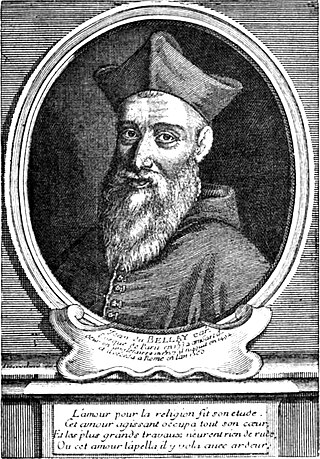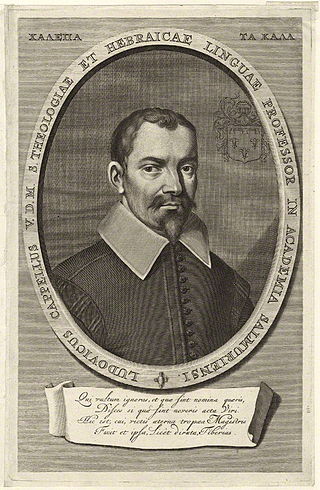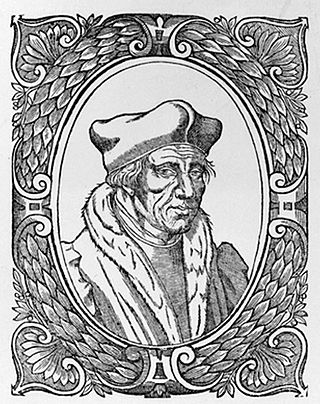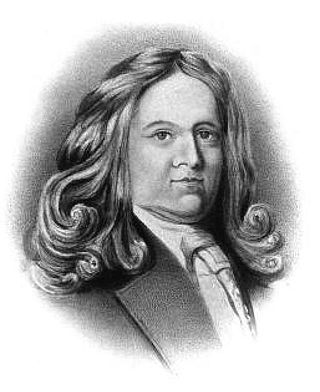Related Research Articles

Jean du Bellay was a French diplomat and cardinal, a younger brother of Guillaume du Bellay, and cousin and patron of the poet Joachim du Bellay. He was bishop of Bayonne by 1526, member of the Conseil privé of King Francis I from 1530, and bishop of Paris from 1532. He became Bishop of Ostia and Dean of the College of Cardinals in 1555.

Louis Cappel was a French Protestant churchman and scholar. A Huguenot, he was born at St Elier, near Sedan. He studied theology at the Academy of Sedan and the Academy of Saumur, and Arabic at the University of Oxford, where he spent two years. At the age of twenty-eight, he accepted the chair of Hebrew at Saumur and, twenty years later, was appointed professor of theology. Amongst his fellow lecturers were Moses Amyraut and Josué de la Place.

François Hotman was a French Protestant lawyer and writer, associated with the legal humanists and with the monarchomaques, who struggled against absolute monarchy. His first name is often written 'Francis' in English. His surname is Latinized by himself as Hotomanus, by others as Hotomannus and Hottomannus. He has been called "one of the first modern revolutionaries".

Franciscus Gomarus was a Dutch theologian, a strict Calvinist and an opponent of the teaching of Jacobus Arminius, whose theological disputes were addressed at the Synod of Dort (1618–19).

Blaise de Vigenère was a French diplomat, cryptographer, translator and alchemist.

Jacques Lefèvre d'Étaples was a French theologian and a leading figure in French humanism. He was a precursor of the Protestant movement in France. The "d'Étaples" was not part of his name as such, but used to distinguish him from Jacques Lefèvre of Deventer, a less significant contemporary who was a friend and correspondent of Erasmus. Both are also sometimes called by the German version of their name, Jacob/Jakob Faber. He himself had a sometimes tense relationship with Erasmus, whose work on Biblical translation and in theology closely paralleled his own.

Renée of France, was Duchess of Ferrara from 31 October 1534 until 3 October 1559 by marriage to Ercole II d'Este, grandson of Pope Alexander VI. She was the younger surviving child of Louis XII of France and the duchess regnant Anne of Brittany. In her later life, she became an important supporter of the Protestant Reformation and ally of John Calvin.

Guillaume du Bellay, seigneur de Langey, was a French diplomat and general from a notable Angevin family under King Francis I.

The House of La Trémoïlle(Maison de La Trémoille in French) was a French noble family from Poitou whose name comes from the village La Trimouille in the départment of Vienne. This family has been known since the middle of the 11th century, and since the 14th century its members have been conspicuous in French history as nobles, military leaders and crusaders, and influential as political leaders, diplomats, Huguenots and courtiers. The male line of the family died out in 1933, while female line heirs of the last duke have kept the La Trémoïlle surname alive in Belgium.

Pierre Boucher de Boucherville was a French settler, soldier, officer, naturalist, official, governor, and ennobled aristocrat in Nouvelle-France or New France.

The Roman Catholic Diocese of Montauban is a diocese of the Latin Church of the Roman Catholic Church in France. The diocese is coextensive with Tarn-et-Garonne, and is currently a suffragan of the Archdiocese of Toulouse. The episcopal seat of the Diocese of Montauban is in Montauban Cathedral.

Guillaume Vandive was a French printer and bookseller. He was a master tradesman under the patronage of the Dauphin of France. Vandive's premises was on the rue Saint-Jacques, Paris. His trade mark was the "Crowned Dolphin". Vandive published books in French and Latin on the topics of Jansenist theology, trade and travel. After his death at age 26, Vandive's business was continued by Nicolas Simart who married Vandive's widow. Family discord and legal actions ensued.
The College of Guienne was a school founded in 1533 in Bordeaux. The collège became renowned for the teaching of liberal arts between the years 1537 and 1571, attracting students such as Michel de Montaigne.
The Academy of Sedan was a Huguenot academy in Sedan in the Principality of Sedan, founded in 1579 and suppressed in 1681. It was one of the main centres for the production of Reformed pastors in France for a hundred years.

Sir John Chichester (1519/20-1569) of Raleigh in the parish of Pilton, near Barnstaple in North Devon, was a leading member of the Devonshire gentry, a naval captain, and ardent Protestant who served as Sheriff of Devon in 1550-1551, and as Knight of the Shire for Devon in 1547, April 1554, and 1563, and as Member of Parliament for Barnstaple in 1559, over which borough his lordship of the manor of Raleigh, Pilton had considerable influence.
Jean de Laforcade, Seigneur de La Fitte, aka Jean Laforcade, Seigneur de Lafitte, aka Jean Lafourcade, aka Jean II. de Forcade, was a Protestant nobleman and a descendant of the noble family of Forcade of Béarn in Navarre.
Robert le Maçon, Sieur de la Fontaine, or Robert Masson, (1534/5–1611) was a French Reformed minister and diplomat. He founded an important church in Orléans which became central to the Huguenot movement during the first French War of Religion 1562.

Madeleine of Savoy (1510–1586) was a French court official, Première dame d'honneur to the queen of France, Elisabeth of Austria, from 1570 until 1574.
Jean Tagault or Jean Tagaut was a French physician and anatomist known for his surgical work and for having fought against Michel Servet who defended judicial astrology and divination as sciences. He is often confused with his son Jean Tagaut, a doctor and poet.
Jean du Tillet was a French nobleman, archivist and historian.
References
- 1 2 3 One or more of the preceding sentences incorporates text from a publication now in the public domain : Chisholm, Hugh, ed. (1911). "Cappel". Encyclopædia Britannica . Vol. 5 (11th ed.). Cambridge University Press. p. 288.
- ↑ Acta Eruditorum: Jacques Cappel also known as Jacobus Tillaeus
- Eugene and Emile Haag, La France protestante, vol. iii. (new edition, 1881).